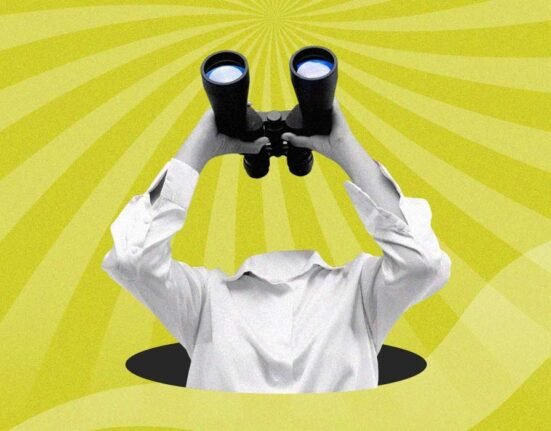Emerging trends nowadays about ‘mental health’ and ‘mental health awareness’ has led to more and more people to talk about it on an open platform. Crowding on various social media platforms about a large chunk of information regarding mental health, mental health disorders, positive mental health and mental health survivors / caregivers of people with mental health concerns. Along with, widely used hashtags such as #imatter #youmatter #i4mentalth #mentalhealthawareness has become a prominent sight to look at. Possibly, the suppression of the issues or crisis of mental health under heavy burden of stigmas and taboos found its way of outward expression for acceptance and non-judgemental attitude through the approachability of the social media. Following the league, various stakeholders and top-notch institutes in the field have felled back on the medium to provide mental health education and make effective use of the same.
Read More: Mental Health Insurance in India
The picture caricatured has been such that it has brought both positive and negative consequences on the surface. Where at one stage, such a bold step on the side of the victim of mental health issues is being appreciated. On the other end, barriers, misinformation, misperception and misinterpretation because of the same are creeping into the society.
This has brought a disturbed understanding, of the focus mental health has and adheres to, among people. This has further posed a challenge to mental health professionals, who have to deal with a plethora of questions, negative bias, and misled prognosis. A question that must have come or have been there for a while would be ‘what could be subsequent step to monitor the situation like this’ or ‘what could be possible steps as an individual I can take to be more responsible towards mental health?’ or ‘what is the succeeding step to awareness while be protective of feeling of identity or belongingness?’
Read More: Debunking the Stigma: 5 Myths About Seeking Mental Health Professional Help
Well, what if you are told that YES! a) There is a succeeding step available b) there is a way you can actively contribute as a responsible citizen being a part of mental health +(ve) community. The step is called – ‘Being a Peer i.e. Mental Health First Aider’. Excited?
Let’s take this enlightening journey to understand all about mental health first aid and how you can be a peer to someone experiencing a mental crisis and encourage rightful help.
What is Mental Health First Aid?
When we see a person suffering from a physical discomfort like fever or snake bite, we have a basic know-how of physical first aid to help the person. But, are we skilled enough to provide the same comfort to a person who is experiencing anxiety, tension or depressive symptoms? A generic reaction of ‘Don’t worry’, ‘it happens to everyone at this stage’. ‘Stop acting kidlike’, ‘you aren’t special’ or ‘things will get better’ are what we offer with limited nature of information we carry.
However, such emotional state carry prolonged or severe effects or might be resultant of traumatic experience, an individual must have suffered. What might seem unreasonable to be worried upon, could be something apt and reasonable cause to show a worrisome behaviour. These signs are then indicative of warrant attention and basic intervention. Mental Health First Aid is a training in these basic intervention measures an individual can take to initiate help and further, on requirement encourage professional help to person in crisis.
Read more: How trauma affects emotional development in children?
Who can be credited for initiation of Mental Health First Aid?
Mental Health First Aid was created in 2001 by Betty Kitchener, a nurse specializing in health education, and Anthony Jorm, a mental health literacy professor. Kitchener and Jorm run Mental Health First Aid Australia, a national non-profit health promotion charity focused on training and research.
According to them, Mental Health First Aid takes the fear and hesitation out of starting conversations about mental health and substance use problems by improving understanding and providing an action plan that teaches people to safely and responsibly identify and address a potential mental illness or substance use disorder.
Who can be a ‘Peer’ – Mental Health First Aider?
Mental health first aid concept accommodates a large variety of people to become a first aider and in progression challenge the existing taboos, stereotypes and misconceptions that have been carried forward across generations. This would further help in sensitizing people about issues which they might not feel exists and its just course of time. Thus, prominently, the model proposes teachers, students, caregivers, facilitators, and people working in the field which require extreme human communication apart from anyone who wants to reach out in distress.
How to go about the process of being a Peer – Mental Health First Aider?
The very important pre-requisite step to initiation of the process is to know that mental health as a subject has been under the pressure of ignorance, hence providing a large ground to building of misconceptions, misinformation and irresponsible behaviour towards those who suffer or show signs of mental health concern. It is often over-read and a thin line between order and disorder is easily violated. It is necessary to understand that we all as humans have array of emotions and varied personalities, thus a simple emotion of anger or crying as one-time behaviour shouldn’t be confused with the persistence in existence of those emotions, cognitive dissonance or harmful behaviour which is repeatedly shown at different places or it is responsible for disrupting a routine. In cases like this, concern is high and it should be taken care by basic and if required professional intervention.
Step 1: Identify the signs and symptoms of Mental Health Problems
As a peer or first aider, it is very important to notice a conspicuous change in the person by focusing on identifying the early signs of a mental health problem. The possible signs could be:
- Looking dull and listless
- Looking sad
- Lack of interests in surroundings
- Crying spells
- Talking of death or suicidal ideation
- Withdrawal from social gatherings
- Anger outburst or excessive aggressive behaviour
- Unusual and expected behaviour
- Change in eating behaviour
- Feeling fatigue
iCall Suicide Helpline; 9152987821
Step 2. Approach the person with respect and dignity
On noticing these signs and symptoms, approach the person with respect and having an empathetic tone. Understand, the person is under the phase of experiencing a change in an unpleasant way, your approach can be looked at as both threatening and welcoming, largely depending on the tone and behaviour of the body. Another thing to keep in mind is that, crisis or problems are part and parcel of life, they also contribute in attaining a virtue too. If you have possibly overcome the issue, help the person in doing so with empathy. Forcing your opinion would be damaging. Weakness doesn’t subjugate the person to lower down the respect, s/he is the same with or without mental health problem. If the person doesn’t accept the offer to help carefully withdraw from the situation. You may later approach them again, but respect the decision at that time and provide that space.
Step 3. Encourage support and acceptance
If the person decides to share the information after being comfortable with you, the next step is, offer time and space to the person. Let the person decide how much s/he wants to share, how s/he wants to share. Being available by sitting and listening to the person can also be considered useful and enough at times. Cognize, sometimes basic activities can be overwhelming as constant thought or trail of thoughts of the experience and can interrupt the normal activities. In such situations, help them, involve them in the process gradually. You should be careful of the words and the way it’s spoken in such cases. If the person feels offended with your words or actions, they can withdraw from help. This can further lead to development of thought that “I am so worthless that even help offered by someone cannot aid me’
While you are involving yourself in this process, be careful, the relationship initiated becomes that of over-dependence with too much ‘being available’ attitude. Thus, on your end maintain a balance between you being there for help and not being over involved.
Step 4. Avoid being judgemental
Given our personal experiences or knowledge about a particular situation, we tend to make a dominating and judgemental view about the person, event or object. These strong views tend to be reflected in our communication with the person which is reflected as detrimental for the person seeking help. One of the possible negative consequences of the same would be; the person requiring aid aligning behaviours in order to generate acceptance of the aider. This situation becomes controversial and burdening, both at later stage.
Thus, it’s important to realise that the context of interaction of two persons might be same at that given point, but the individuals involved are coming from different contexts or situations depending upon their course of life. (This includes opinions, attitudes, emotions etc.)
Accordingly, monitoring oneself by recognizing and refraining the judgements becomes of utmost importance while offering help.
Step 5. Be a good Listener
Listening is an extensive process which holds great importance in this process. We often communicate to reply or react in today’s scenario, than to carefully respond to the person. Lending an ear to someone is a great step as, you not only participate by hearing but also involve yourself cognitively to understand the situation.
Read More: The Healing Power of a Good Listener
While you listen to someone, some tips you can keep in mind:
- Avoid poking unnecessarily, let the person complete what s/he wants to convey.
- Maintain a good posture which welcomes the person to communicate with you.
- Avoid negative communication through paralanguage, make your gestures impactful not remorseful
- Refrain from asking too much questions.
- Let the person ventilate his or her feelings.
Step 6. Give Hope to them for recovery
- Instil hope that their problems can be addressed in a constructive manner with a mental health professional or a supportive family member and coping skills can be strengthened.
- You can do be supportive and help them acknowledge how difficult their current state is for them.
Step 7. Make them comfortable with the idea of seeking help
Referring the person to a mental health professional at the earliest,
- If an intent to harm self is strong, or has already been attempted.
- Or, if the problem persists for long and first aid assistance isn’t proving of much help or a lack of awareness regarding these problems is there among the individuals
Step 8. Follow -up
Once treatment is started, continuity in treatment is important till the person feels healthy and stable again in their life, because if a person has shown suicidal behaviours, it often makes them vulnerable to attempting these again unless its underlying causes are dealt with.
Step 9. Build coping strategies
Apart from medicinal and psychotherapy intervention, its important to work upon making the individual realize that s/he is a part of the community and society is inclusive toward the person through active support and networking. They, after recovery, can help others by participating and connecting others in the society and disseminate good education regarding available help.
To sum up, mental health is possible to cure, help is available, and knowledgeable and practising individuals are there, we have to throw enough light on what is right or wrong. These strategies are possible and achievable and holds capability to make a difference. Just like ‘YOU’ can. You are Capable of much more than you limit yourself to think of, with resources likes these, lets also discover a valuable side to ourselves.













Leave feedback about this